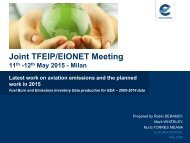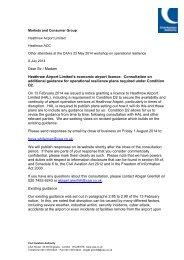NATS-Annual-Report-2015
NATS-Annual-Report-2015
NATS-Annual-Report-2015
Create successful ePaper yourself
Turn your PDF publications into a flip-book with our unique Google optimized e-Paper software.
<strong>Annual</strong> <strong>Report</strong> and Accounts <strong>2015</strong> | <strong>NATS</strong> Holdings Limited<br />
Financial Statements 95<br />
Notes forming part of the<br />
consolidated accounts<br />
(continued)<br />
Internally-generated intangible assets are amortised on<br />
a straight-line basis over their useful lives, typically over<br />
3 to 12 years. Assets in the course of construction are not<br />
amortised. Where no internally-generated intangible asset<br />
can be recognised, development expenditure is recognised<br />
as an expense in the period in which it is incurred.<br />
Impairment of tangible and intangible assets<br />
excluding goodwill<br />
At each balance sheet date, the group reviews the carrying<br />
amounts of its tangible and intangible assets, including<br />
those in the course of construction, to determine whether<br />
there is any indication that those assets have suffered<br />
an impairment loss. If any such indication exists, the<br />
recoverable amount of the asset is estimated in order<br />
to determine the extent of the impairment (if any).<br />
Where the asset does not generate cash flows that are<br />
independent from other assets, the group estimates the<br />
recoverable amount of the cash-generating unit to which<br />
the asset belongs.<br />
Recoverable amount is the higher of net realisable value<br />
less costs to sell and the value in use. In assessing value in<br />
use, the estimated future cash flows are discounted to their<br />
present value using the pre-tax nominal regulated rate of<br />
return.<br />
If the recoverable amount of an asset (or cash-generating<br />
unit) is estimated to be less than its carrying amount, the<br />
carrying amount of the asset (cash-generating unit) is<br />
reduced to its recoverable amount. An impairment loss is<br />
recognised as an expense immediately.<br />
Where an impairment loss on an intangible or tangible<br />
asset, excluding goodwill, subsequently reverses, the<br />
carrying amount of the asset (cash-generating unit) is<br />
increased to the revised estimate of its recoverable amount,<br />
but so that the increased carrying amount does not exceed<br />
the carrying amount that would have been determined had<br />
no impairment loss been recognised for the asset (cashgenerating<br />
unit) in prior years. A reversal of an impairment<br />
loss is recognised in the income statement immediately.<br />
Emissions allowances<br />
Consistent with the withdrawal of IFRIC 3, emissions<br />
allowances previously recognised at a valuation are now<br />
recognised at cost. Emissions allowances granted free of<br />
charge are recognised at nil value on the balance sheet as<br />
an intangible asset. As carbon is produced and an obligation<br />
to submit allowances arises, a provision is created. The<br />
provision is measured at book value (nil or carrying amount<br />
of purchased emissions certificates) of the recognised<br />
emissions certificates. If there is an obligation that is not<br />
covered by allowances already on the balance sheet, the<br />
corresponding provision made is measured at current<br />
market prices.<br />
Amounts recoverable on contracts<br />
Where the outcome of a contract can be estimated reliably,<br />
revenue and costs are recognised by reference to the stage<br />
of completion of the contract activity at the balance sheet<br />
date. This is normally measured by the proportion that<br />
contract costs incurred for work performed to date bear<br />
to the estimated total contract costs, except where this<br />
would not be representative of the stage of completion.<br />
Variations in contract work, claims and incentive payments<br />
are included to the extent that they have been, or are more<br />
likely than not to be, agreed with the customer.<br />
Where the outcome of a contract cannot be estimated<br />
reliably, contract revenue is recognised to the extent<br />
of contract costs incurred that it is probable will be<br />
recoverable. Contract costs are recognised as expenses<br />
in the period in which they are incurred.<br />
When it is probable that total contract costs will exceed<br />
total contract revenue, the expected loss is recognised as<br />
an expense immediately.<br />
Share-based payments<br />
The group has applied the requirements of IFRS 2: Share-<br />
Based Payments.<br />
In 2001, the company established an All-Employee Share<br />
Ownership Plan for the benefit of its employees to hold 5%<br />
of the share capital of <strong>NATS</strong> Holdings Limited. The Plan<br />
Financial<br />
Statements






